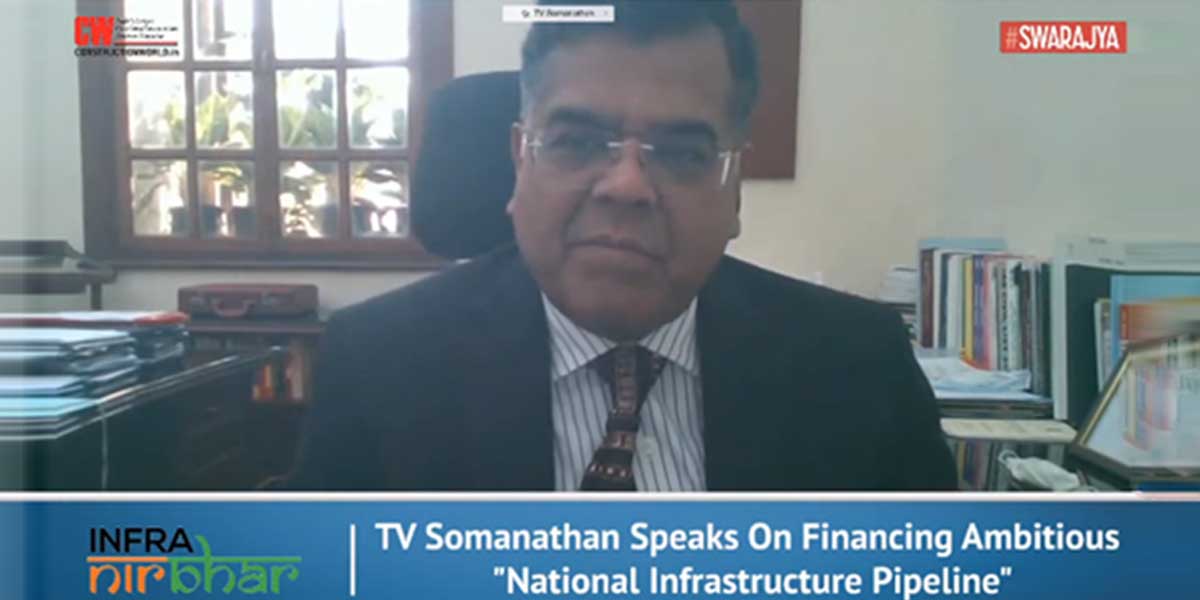Infrastructure projects cannot be funded like other projects and there are at least two characteristics of infrastructure projects that distinguish them from most other projects in a modern economy━they experience the phenomenon of public goods effects, and have long gestation periods, said Dr TV Somanathan, Secretary (Expenditure), Ministry of Finance, Government of India. “Infrastructure projects actually involve in their last decision-making stage a leap of faith and assumption that it will actually work.”
Somanathan was addressing a webinar on Tuesday (February 23) on infrastructure finance, the second in the Infra-Nirbhar webinar series organised by Construction World and Swarajya magazines.
He added that the social return for infrastructure projects are often ignored by number-crunchers, although in reality, the outcomes bear returns much higher than the numerically captured internal returns: “Any attempt to estimate an internal rate of return or a net present value from the point of view of the project developer is usually underestimated. Look at what's the NPV of the Chennai Metro Rail project, which I once headed. It is not over 5%. Now, at that value, most parties might not find the project worth their time [to invest in]. But the social returns are usually 19-20%. And that is why metro rail projects are built … If only internal returns were to matter, the Suez Canal would not have been built.”
On viability, Somanathan said that infrastructure “almost always” requires some kind of governmental intervention, “even in a free-market economy”, because not all of the variables can be captured in any risk analysis or financial analysis.
Six ways to fund infrastructure
According to Somanathan, the following six ways will help accomplishing the funding challenges of infrastructure:
Enhanced central public expenditure or central capital expenditureEnhanced capital expenditure by state governmentsRecycling of old public assets by creating a new institutional structure for structure financeEncouraging private capital to flow into infrastructure in a bigger waySteps to stimulate the long term bond market in the budget there's an announcement of a backstop facility for long term bonds, which will aim to create a market making institution which will provide liquidity to bonds, other than government bonds.
Create a non-government facility that is a market maker and provide liquidity to corporate and infrastructure bonds.
Interaction with Dr TV Somanathan
Here are excerpts of an interactive session with Dr TV Somanathan. The interaction was moderated by Pratap Padode, Editor-in-Chief, Construction World, and Dr Shubhada Rao, Founder, QuantEco Research.
Padode: You said that we have a 35% increase in allocation for the given the National Infrastructure Pipeline. I think the total difference was around seven 7 trillion. Given that nearly over 21 trillion needed to be spent by 2021. Have we accounted for all of that, within this 35% increase or is there some, you know, on unfinished sources that we need to tap.
Somanathan: No, the government's provision in the budget is not sufficient to completely account for what is required, on a year to year basis, the national infrastructure pipeline, the total funding will consist of the government, plus states, plus private sectors, i.e. central plus states plus private sector. This is broadly, our proportion of it, but yes more money will have to come from it. No doubt about it.
Rao: Centre and states provide the maximum buck to the bank, we see that particularly center’s expenditure on capex has 1.6 times larger multiplier compared to states capex and center’s capex has a larger multiplier on GDP by almost seven times compared to the revenue expenditure. But the larger challenge perhaps not as much from the center but states does emerge because we have seen that until December 20, you know, only the state 17 key states have done a capex of only 34% of the budgeted amount. Obviously there are funding challenges within the state governments. So how are we proposing to resolve this kind of a constraint?
Somanathan: But we're also looking at ways of incentivising the state to spend a larger proportion of its own budget on capital.And we are mindful of the autonomy of the states, everybody wants state autonomy except when you don't like it. So, we continuously face these challenges of the differing demands of different commentators and sometimes the same commentator at different times. So we are looking at what we can do, which is appropriate, but we do realise that something needs to be done about it, you should excuse me for not being specific about it.
Padode: Since we are also looking at foreign capital via sovereign wealth funds, etc. to finance infrastructure. And these funds typically look at something which is at least, you know, more than double A in terms of rating, and most of our infrastructure projects are below double A. So, it is critical to enhance the rating to augment the access of these institutional investors, what can be done about that.
Somanathan: Yeah, I think the new development finance institution (DFI), one of its areas of operation would be on credit enhancement is my conjecture. That, again we are willing to put some government money behind these initiatives. So if you have a project that is low rated, then we can upgrade the rating with a little bit of sovereign help in terms of you know first losses or some kind of guarantees or some backup from either state or central government so that's an important aspect, if it's an investment in a project. The other ways of course, you use an intermediary to channel the private funds where the private funds don't go into a low rated institution but they come into a higher rated institution, the higher rated institution, makes some of its investments in lower rated institutions. So, these are some of the ways that we would work on it and I think the new institution is going to be important in accomplishing these things.
Padode: The other area which has probably not been accounted for in the NIP is the unfinished or abandoned or stock projects. These would be the projects that may need funding, with this in mind, maybe we could think of deploying InfraNirbhar projects Mission Director on the lines of what had been done during the stuck projects time previously, who can target these projects and get them to fruition. What is your view?
Somanathan: I think there are two kinds of stalled or stuck projects, the ones that are purely government projects we have a system currently called Pragati, which is actually chaired by the Prime Minister himself, which is actually effective in the old stuck projects. We have private projects or projects that have a private element, and also some public interface. I think you're right that there is certainly some scope or, you know, better coordination from the government side, if it involves public agencies, state government, clearances, environment forest, land acquisition. But in the projects, we don't have too much public interface, we have a lot of those too. And those are mostly stuck in the NCLT. As for a Mission Director, I think it can be helpful where the problem is largely government, say where the problem is that the state government has suddenly withdrawn etc. Those can be solved through administrative support, but if you have a project that is, you know, stuck because of solvency issues, then it becomes more of a financial resolution where NCLT comes into play.
Rao: If I were to showcase the newly created DFI how different would I position it versus the earlier created a long term institution for infra like IIFCL?
Somanathan: Well I think it's going to be much bigger in size than IIFCL. So I think, scale is one important dimension in which it's going to be very different. Second, I think this is now part of a more integrated strategy where this is an institution that aspires to create an infrastructure financing ecosystem in a way that let's say National Housing bank has done for housing or the, you know, NABARD has done for agriculture.
Padode: Asset monetisation is going to play a very important part in gathering the revenue. And as you know this is a very difficult subject in terms of, you know, bringing it from all the public sector, and then putting it together. And that's why it enjoys a sense of a little incredibility from people. So, we need to take care of that in the sense of actually demonstrating how this will be done in order to win that credibility back into this asset monetisation program. And of course the divestment program is more credible from our point of view, asset monetisation is more difficult. Your comments?
Somanathan: I fully agree with you that asset monetization is more difficult, because the disinvestment we do through market based share transactions where pricing is much more transparent asset sales of land or You know other assets, don't have that level of market price discovery. And you know that we have a history in our country of prosecuting public servants who sell public assets. So, public servants who sell public assets have to be conscious of that history. However, I think we also have to be conscious of the changes in law that have happened recently in the prevention of corruption Act, which in 2018 was amended to remove the section under which many honest public servants, could be held guilty of corruption, because what that old section had was that if you've taken a decision and someone had got a pecuniary gain without public interest, then the public servant might be guilty of corruption. There was no element of guilt or personal gain or, you know, bribe or nothing of the kind. That is no longer part of the statute book.
You may note that in the Budget speech we referred to the creation of a new agency for disposing off government land, which we said would be managed on private sector lines, so precisely because we see these problems we are attempting the creation of a new institutional structure and Management Agency, managed privately. So that is the other way that we are planning to tackle it. The third thing is, which I would say is the mere fact that we are saying it is also important. We have not previously said privatise, we have said it now. So, that reflects a certain key, how important is that change, you may say that you're waiting for the action Well, you're right to wait for the action but we intend to act.


















